Usability courses
Disability courses
About this course
In this half day course, you will learn about:
- The changing meaning of ‘design’
- Approaches to UX
- Accessibility and inclusion
- Research in UX
- UX deliverables
This course is for people who:
-
- Are making a new online service
- Are improving an existing online service
- Need to assess the quality of design work
- Want to build design capacity in their team
The online version of this course uses a combination of:
-
- small group discussions (breakouts)
- collaboration tools (such as whiteboards and polls)
- lecture content (with slides)
- video content
This course has been developed with accessibility in mind.
Find out more about how Great Question courses are taught online
The in-person version of this course uses a combination of:
-
- small group discussions
- collaboration tools (for example: pen and paper, sticky notes)
- lecture content (with slides)
- video content
The in-person version of this course has been developed with accessibility in mind.
This course was designed with the needs of the APS (Australian Public Service) in mind.
It is informed by:
Learning outcomes from the APS learning design standards for digital can be found at the bottom of this page.
What you’ll learn
Key learning outcomes
At the end of this course, you will be able to:
- Understand that design is a problem-solving discipline
- Understand that design is a process based discipline
- Describe the basic steps of ‘design thinking’
- Describe the Double Diamond design process model
- Create a problem statement
- Explain the difference between ‘discovery research’ and ‘usability research’
- Name and describe common activities in discovery research
- Name and describe common artefacts generated from discovery research
- Explain the fundamentals of usability research
- Describe the value of different kinds of prototypes
- Describe what a Design System is
APSC learning outcomes
This course aligns to learning outcomes set out in the APSC (Australian Public Service Commission) Learning Standards for Digital and the SFIA digital skills and competency framework.
Interaction design
1. Introduction to Interaction Design in an Agile Government Digital Context
1.2 Introduction to Interaction Design: explain the fundamentals of Interaction Design
2. User research for Interaction design
2.1 Understand the problem set and the needs of the User: discover the needs of the user, undertake research to generate user insights along with the User Researcher.
2.2 User Research for the purposes of Interaction Design: design, run and analyse experiments which generate user insights
3. Key Skills of Interaction Design
3.1 Principles of design
– Apply the principles of design in a digital context
Agile delivery management
5. Managing an agile delivery team
5.3. User centricity and the agile team: describe a user centred approach and how it informs the product backlog
Accessible and inclusive government services
1. Accessible and inclusive Australian Government services
1.1. Defining accessibility and inclusion: explain the importance of making Australian Government services inclusive and accessible.
2. Accessibility compliance requirements and guidelines
2.1 Mandatory requirements for accessibility: comply with accessibility legal and policy framework
2.3 Assistive technology: design for common types of assistive technologies and adaptive strategies
4. Championing accessibility within your organisation
4.1 Accessibility performance: assess, monitor, and report on the accessibility performance and capability of your organisation

